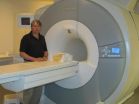Only the weak survive?: Pitt team adds more give for stronger self-healing materials
A Pitt and Carnegie Mellon team developed a new model of how self-repairing materials function and show that materials with a certain number of easily breakable bonds can absorb more stress, a natural trick found in the resilient abalone shell
2011-03-24
(Press-News.org) PITTSBURGH—Conventional rules of survival tend to favor the strongest, but University of Pittsburgh-based researchers recently found that in the emerging world of self-healing materials, it is the somewhat frail that survive.
The team presents in the journal Langmuir a new model laying out the inner workings of self-healing materials made of nanoscale gel particles that can regenerate after taking damage and are being pursued as a coating or composite material. Moreover, the researchers discovered that an ideal amount of weak bonds actually make for an overall stronger material that can withstand more stress.
Although self-healing nanogel materials have already been realized in the lab, the exact mechanical nature and ideal structure had remained unknown, explained Anna Balazs, corresponding author and Distinguished Professor of Chemical Engineering in Pitt's Swanson School of Engineering. The team's findings not only reveal how self-healing nanogel materials work, but also provide a blueprint for creating more resilient designs, she said. Balazs worked with lead author and Pitt postdoctoral researcher Isaac Salib; Chet Gnegy, a Pitt chemical and petroleum engineering sophomore; German Kolmakov, a postdoctoral researcher in Balazs' lab; and Krzysztof Matyjaszewski, a chemistry professor at Carnegie Mellon University with a special appointment in Pitt's Department of Chemical and Petroleum Engineering.
The team worked from a computational model Gnegy, Kolmakov, and Salib created based on a self-healing material Matyjaszewski developed known as nanogel, a composition of spongy, microscopic polymer particles linked to one another by several tentacle-like bonds. The nanogel particles consist of stable bonds—which provide overall strength—and labile bonds, highly reactive bonds that can break and easily reform, that act as shock absorbers.
The computer model allowed the researchers to test the performance of various bond arrangements. The polymers were first laid out in an arrangement similar to that in the nanogel, with the tentacles linked end-to-end by a single strong bond. Simulated stress tests showed, however, that though these bonds could recover from short-lived stress, they could not withstand drawn out tension such as stretching or pulling. Instead, the team found that when particles were joined by several parallel bonds, the nanogel could absorb more stress and still self-repair.
The team then sought the most effective concentration of parallel labile bonds, Balazs said. According to the computational model, even a small number of labile bonds greatly increased resilience. For instance, a sample in which only 30 percent of the bonds were labile—with parallel labile bonds placed in groups of four—could withstand pressure up to 200 percent greater than what could fracture a sample comprised only of stable bonds.
On the other hand, too many labile linkages were so collectively strong that the self-healing ability was cancelled out and the nanogel became brittle, the researchers report.
The Pitt model is corroborated by nature, which engineered the same principle into the famously tough abalone shell, Balazs said. An amalgamation of microscopic ceramic plates and a small percentage of soft protein, the abalone shell absorbs a blow by stretching and sliding rather than shattering.
"What we found is that if a material can easily break and reform, the overall strength is much better," she said. "In short, a little bit of weakness gives a material better mechanical properties. Nature knows this trick."
###
END
ELSE PRESS RELEASES FROM THIS DATE:
2011-03-24
Patrick Stroman's work mapping the function and information processing of the spinal cord could improve treatment for spinal cord injuries.
"Basic physiology books describe the spinal cord as a relay system, but it's part of the central nervous system and processes information just like parts of the brain do," explains Dr. Stroman, director of the Queen's MRI Facility and Canada Research Chair in Imaging Physics.
Dr. Stroman's research is directed at precisely mapping the areas above and below a spinal cord injury in order to better determine the precise nature of ...
2011-03-24
We hold many beliefs about memory—for instance, if you study more, you learn more. We are also constantly making judgments about particular instances of learning and remembering—I'll never forget this party! That was easy to understand. I'll ace it on the test.
But do beliefs influence judgments, and how do judgments affect memory performance? "There's a disconnect among beliefs, judgments, and actual memory," says Williams College psychologist Nate Kornell. Ask people to predict how or what they will learn and "in many situations, they do a breathtakingly bad job." ...
2011-03-24
DETROIT – Ninety percent of cancer deaths resulted from metastasis, the spread of cancer to different areas in the body, yet scientific exploration of the possible mechanical factors that promote metastasis has been limited. A Wayne State University researcher, however, is expanding the scientific understanding of what makes malignant tumors spread, and the answer lies within the dense, fibrous matrix that surrounds cancer cells.
Karen A. Beningo, Ph.D., assistant professor of biology in WSU's College of Liberal Arts and Sciences and resident of Plymouth, Mich., has ...
2011-03-24
RENO, Nev. – In a lakewide study, a team of scientists lead by University of Nevada, Reno limnologist Sudeep Chandra has found a considerable decline in native fish species density at Lake Tahoe since 1951. In their final report, they are recommending establishing and implementing a management plan to protect the nearshore zone habitat, which is critical to native fish.
"The numbers are alarming, and likely caused by multiple stressors in the nearshore zone," Chandra an assistant professor in the University's Department of Natural Resources and Environment said. "The ...
2011-03-24
A University of Alberta-led research team has discovered that insects that bore into trees as long ago 90 million years, or as recently as last summer, leave a calling card that's rich with information.
The information is contained in the resin found within trees and on their bark. Resin is produced in large quantities by a tree when it's under attack by insects.
Normally, to assess if a tree is under an attack from boring insects researchers have sometimes had to rip patches of bark from healthy trees. But now forestry workers looking for the telltale sign of insect ...
2011-03-24
A mother's iron deficiency early in pregnancy may have a profound and long-lasting effect on the brain development of the child, even if the lack of iron is not enough to cause severe anemia, according to a University of Rochester Medical Center study published in the scientific journal PLoS One.
The results are important because obstetricians might not notice or treat mild or moderate iron deficiency, and therefore the study authors believe their research underscores the need for monitoring a pregnant woman's iron status beyond anemia.
Low iron is so common that an ...
2011-03-24
Victims of severe traumatic elder abuse are more likely to be female, suffer from a neurological or mental disorder, and to abuse drugs or alcohol, according to research published in the March issue of the Journal of the American Geriatrics Society.
"Past studies have shown that alcohol abuse by the perpetrator plays a substantial role and is strongly associated with physical abuse," says Lee Friedman, assistant professor of environmental and occupational health sciences at the University of Illinois at Chicago and lead author of the study. "Our findings indicate that ...
2011-03-24
Ann Arbor, Mich. — In 1998, a study linking the measles, mumps and rubella (MMR) vaccine to autism in children appeared in a respected medical journal. For a decade, the study grabbed headlines worldwide. Worried parents rejected the life-saving vaccine for their children and those with autistic children agonized that they allowed an injection that caused the condition.
But the vaccine-autism research was a fraud. The paper was retracted 12 years later, denounced as an elaborate deception.
"The fraud in that MMR study epitomizes how fabricated research can lead to a ...
2011-03-24
BLOOMINGTON, Ind. -- An Indiana University study found that a smoke-free air law implemented in an Indiana community did not hurt business at the off-track betting facility in that community. The findings, the researchers said, suggest there is "no economic reason for policymakers to exclude OTB facilities from smoke-free legislation."
Indiana legislators currently are debating a statewide smoke-free air law. Exceptions could include casinos and other gaming venues. Jon Macy, assistant professor in IU's School of Health, Physical Education and Recreation and lead author ...
2011-03-24
COLUMBIA, Mo. – Field tests by University of Missouri scientists have backed up laboratory research indicating that buffer strips of grass and other plants can reduce the amount of herbicide and veterinary antibiotics in surface runoff from farm plots.
Vegetative buffer strips have already proven effective in limiting erosion as well as reducing sediment and nutrients in runoff.
The findings come amid concerns about the potential of veterinary antibiotics in surface water leading to the emergence of antibiotic-resistant bacteria. The antibiotics can enter the environment ...
LAST 30 PRESS RELEASES:
[Press-News.org] Only the weak survive?: Pitt team adds more give for stronger self-healing materials
A Pitt and Carnegie Mellon team developed a new model of how self-repairing materials function and show that materials with a certain number of easily breakable bonds can absorb more stress, a natural trick found in the resilient abalone shell


